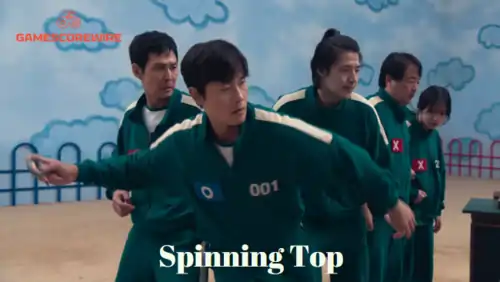
Table of Contents
Introduction
In Squid Game Season 2, Episode 4, “Spinning Top” serves as the fourth game in the high-stakes six-legged pentathlon. At first glance, the game appears deceptively simple—players must wrap a string around a spinning top and launch it onto the floor to make it spin. However, like all challenges in Squid Game, the seemingly innocent childhood pastime is infused with anxiety and danger, pushing contestants to their physical and psychological limits.
Overview of the “Spinning Top” Game
Basic Rules of the Game
The objective of “Spinning Top” is straightforward:
- Prepare the Top: Players wrap a string around a spinning top.
- Launch the Top: Using a specific technique, they fling the top onto the floor with enough force and precision to make it spin.
- Avoid Failure: If the top doesn’t spin or topples over, the player must quickly reset and try again until they achieve a successful spin.
The game requires a blend of technique, timing, and finesse. While it’s easy to grasp conceptually, executing a perfect spin under pressure is far more challenging.
The Challenges of “Spinning Top”
The Element of Timing
“Spinning Top” is the fourth game in the six-legged pentathlon, meaning players arrive at this stage already depleted from the physically and mentally demanding earlier games, such as “Gonggi” and “Flying Stone.” By this point, time is running out, adding immense pressure to perform quickly and flawlessly.
The Technique Trap
Mastering the spinning technique is critical. Players must wrap the string tightly and release it with just the right amount of force and angle to ensure the top spins instead of toppling. This technical requirement leaves little room for error, especially for those unfamiliar with the game.
Stress and Fatigue
As the fourth game in a sequence, “Spinning Top” capitalizes on players’ exhaustion—both physical and emotional. The ticking timer looms heavily over contestants, amplifying their anxiety and increasing the likelihood of mistakes.
Key Elements in “Spinning Top”
The Spinning Tops
The tops used in this game vary in shape and size, introducing an element of unpredictability. Some tops may spin easily, while others require more precision, making the task more difficult for certain players.
The String Mechanism
The strings provided are standardized but require skill to use effectively. Players must balance speed with careful preparation, as improperly wrapping the string can sabotage the spin.
The Setting
The game takes place in a confined, brightly lit arena, with a smooth floor designed to optimize spinning. The sterile environment contrasts with the players’ frenzied attempts, emphasizing their desperation.
Psychological Strain in “Spinning Top”
The Pressure to Perform
By the time players reach “Spinning Top,” they are acutely aware that time is running out. This urgency forces them to balance precision with speed, creating a nerve-wracking scenario where every second counts.
The Fear of Failure
The simple mechanics of the game heighten the fear of failure—there’s nothing complex to hide behind. A failed spin is visible to everyone, increasing the emotional toll and adding public scrutiny to an already stressful task.
The Chain Effect
As with all games in the pentathlon, players are chained together. If one player struggles, their failure impacts the entire team, creating tension and friction among teammates. This dynamic highlights the fragility of trust and cooperation under extreme pressure.
Themes and Symbolism in “Spinning Top”
The Simplicity of Survival
“Spinning Top” epitomizes how even the simplest tasks become Herculean under the weight of survival. The game transforms an innocent childhood pastime into a harrowing challenge, reflecting how societal pressures can distort basic activities into anxiety-inducing struggles.
Time as the Ultimate Adversary
The game underscores the oppressive nature of time, which becomes a relentless adversary for the players. The dwindling clock serves as a metaphor for real-life deadlines, where stress and urgency often lead to mistakes and failure.
Team Dynamics Under Stress
The chained players symbolize the interconnectedness of human lives. Success or failure in “Spinning Top” depends on the group’s ability to support—or at least tolerate—each other, mirroring the delicate balance of relationships in high-pressure environments.
Impact on Viewers
“Spinning Top” resonates with audiences for its relatable simplicity paired with the extreme tension unique to Squid Game. The juxtaposition of a childhood game and a life-or-death scenario creates a gripping narrative that keeps viewers on the edge of their seats. The team dynamic and the players’ individual struggles add emotional depth, making the game a memorable highlight of Season 2.
Final Thoughts
“Spinning Top” in Squid Game Season 2, Episode 4, is a masterclass in turning an everyday activity into a suspenseful spectacle. The game’s blend of simplicity, precision, and time pressure encapsulates the essence of Squid Game—a brutal commentary on human endurance, teamwork, and survival under extreme conditions. As the players battle the clock and their own anxieties, “Spinning Top” delivers an unforgettable mix of tension, strategy, and emotional intensity.
Disclaimer: This article is for informational and entertainment purposes only. It discusses fictional content from the television series Squid Game. All rights to the series, characters, and related content belong to their respective creators and copyright holders.








